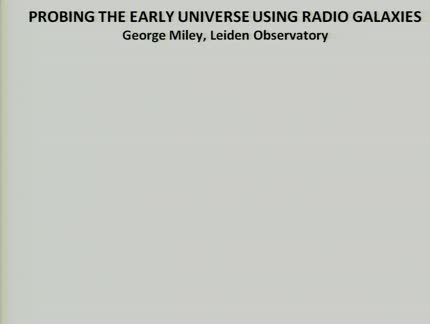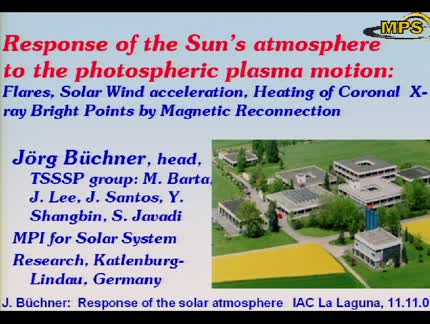Found 111 talks archived in Telescopes and instrumentation

Abstract
Measuring the Aerosol Optical Depth (AOD) is of particular importance in monitoring aerosol contributions to global radiative forcing and air quality. Most measuring methods are based on direct or indirect observation of sunlight and thus are only available for use during daylight hours. Attempts have been made to measure AOD behavior at night from star photometry, and more recently moon photometry. Star photometry method uses spectrally calibrated stars as reference targets this provides somewhat more flexibility than a sun photometer but there are low-signal and calibration issues which can make these measurements problematic. Moon photometry is only possible when the moon is present in the sky. We suggest a complementary method, based on the observation of artificial sky glow generated by light pollution. The methodology requires (1) the implementation of an heterogeneous 3D light pollution model and (2) the design of an automated light pollution spectrometer which will be presented here. The instrument designated as the Spectrometer for Aerosol Night Detection (SAND) is now in its third version. Basically, SAND-3 is an automated CCD based, long-slit spectrometer protected from inclement weather by an acrylic dome. SAND have been used successfully in many astronomical sites along with some urban sites. Our first day/night (continuity) AOD measurements comparisons with AERONET/AEROCAN sunphotometer data will be shown for Sherbrooke university (Quebec, Canada) atmospheric optical observatory.
Abstract
An analysis of the impact of seismic and volcanic activity was carried out at selected astronomical sites, namely the observatories of El Teide (Tenerife, Canary Islands), Roque de los Muchachos (La Palma, Canary Islands), Mauna Kea (Hawaii) and Paranal (Chile) and the candidate site of Cerro Ventarrones/Armazones (Chile). In this sense, we studied the impact of seismicity, volcanic ash clouds, lava flows and ground deformation. Hazard associated with volcanic activity is low or negligible at all sites, whereas seismic hazard is very high in Chile and Hawaii. The lowest geological hazard in both seismic and volcanic activity was found at Roque de los Muchachos observatory, in the island of La Palma.

Abstract
Survey operations with the VISTA telescope with it wide field near IR camera started in Feb 2010, following a science verification phase that started in Oct, 2009. I will describe this new 4.2m wide field telescope and the ESO VISTA Public survey program. I will give details of all ESO six public surveys which will be used for a range of galactic and extragalactic science. I am the PI of the largest, by area, VISTA survey, I will focus my talk on the VISTA Hemisphere Survey and I will show how this survey will be used to find quasars in the Epoch of Reionization at redshift greater than 7. The VISTA Hemisphere Survey (VHS) has been been awarded 300 clear nights on the 4.2m ESO VISTA telescopes. VHS observations started i February, 2010 and the survey will take 5 years to complete. The VHS will cover the whole southern celestial hemisphere (dec<0) to a depth 4 magnitudes fainter than 2MASS/DENIS in at least two wavebands J and K. In the South Galactic Cap, 5000 square degrees will be imaged deeper, including H band, and will have supplemental deep multi-band grizY imaging data provided by the Dark Energy Survey (DES). The remainder of the high galactic latitude sky will be imaged in YJHK and combined with ugriz wavebands from the VST ATLAS, SDSS BOSS and Skymapper optical surveys. The medium term scientific goals include: a huge expansion in our knowledge of the lowest-mass and nearest stars; deciphering the merger history and genesis of our own Galaxy; measurement of large-scale structure out to z=1 and measuring the properties of Dark Energy; discovery of the first quasars with z > 7. In my talk, I will describe the scientific motivation and methodology of the search for quasars with z > 7.
Abstract
Over the next decade or so, the gravitational-wave window onto the Universe will be opened in four frequency bands that span 22 orders of magnitude: The high-frequency band, 10 to 10,000 Hz (ground-based interferometers such as LIGO and VIRGO), the low-frequency band, 10-5 to 0.1 Hz (the space-based interferometer LISA), the very-low frequency band, 10-9 to 10-7 Hz (pulsar timing arrays), and the extremely-low-frequency band, 10-18 to 10-16 Hz (polarization of the cosmic microwave background). This lecture will describe these four bands, the detectors that are being developed to explore them, and what we are likely to learn about black holes, neutron stars, white dwarfs and early-universe exotica from these detectors' observations.

Instituto de Astrofísíca de Canarias, Spain
Abstract
There are many parameters accounting for the quality of an astronomical site, namely seeing, cloud cover, ground winds, high-altitude winds, etc. The water vapor content is the main parameter affecting the IR quality of astronomical sites. The fraction of nights with good IR conditions (small column of water vapor) as a function of the epoch of the year will allow an optimal scheduling of telescope observing time. Global Positioning System (GPS) is an increasingly operational tool for measuring the precipitable water vapor (PWV). In this seminar, we briefly describe the procedure to estimate the PWV through GPS and we present the statistical results derived from a 7.5-year long time series of PWV estimations derived from GPS at the Roque de los Muchachos Observatory.

Abstract
In this Breaking News seminar, I will describe our project dedicated to the search for ultracool low-metallicity dwarfs (or subdwarfs) in the large-scale databases. The highlight of the seminar is the discovery of a mid-L subdwarf, the fifth known to date, and the first one identified in the UKIRT Infrared Deep Sky Survey (UKIDSS). The spectroscopic nature of this subdwarf was confirmed with data obtained with GTC/OSIRIS in April 2009.
Abstract
Luminous high-redshift radio galaxies (HzRGs) are associated with the most massive known galaxies in the early Universe. These galaxies have the properties expected of the progenitors of dominant galaxies in rich clusters.
I shall describe the properties of HzRGs and demonstrate how they can be used to study the formation and evolution of galaxies and clusters. I shall also show how LOFAR, the new European radio telescope, can be used to extend these probes into the epoch of reionisation.

Abstract
The ambitious astrophysical objectives of the Extremely Large Telescopes (ELTs) will be achievable only with innovative Adaptive Optics (AO) systems to correct for the wavefront distortions induced by the turbulence in the atmosphere. One of the key components of an AO system is the wavefront reconstruction, which is a real-time estimate of the wavefront distortions above the telescope aperture from data. This reconstruction can be described by an inverse problem approach (IPA),taking advantage of the modeling of second-order statistics of both turbulence and data noise.First, the benefits of the IPA to wavefront reconstruction is enhanced for two particularities of the ELTs: very high number of estimated parameters (~104) and elongated spots on the sensor for AO using Laser Guide Stars. Moreover, this IPA can be implemented with a fast algorithm for high number of degrees of freedom, which makes it a candidate for the implementation on a future AO system of the E-ELT. The correction performance in closed-loop AO has also been assessed thanks to end-to-end simulations of single-conjugate AO and Ground-Layer AO with Laser Guide Stars on the E-ELT.

Abstract
In 2006, NAOJ proposed to construct the Hyper Suprime-Cam (HSC) as a second generation instrument for Subaru telescope. This is a very wide-field camera covering 1.5 degrees of sky at a time. The focal plane area to be covered will be around 530mm. A total of 110 2kx4k CCD detectors will be placed adjacent to each other in order to cover this large field of view. The HSC will be a prime focus camera, and will enlarge the current field of view (FOV) of Subaru, as provided by the first generation Suprime Cam, by a factor of 10. The HSC will be the largest CCD camera in the world, and will have a total performance, as measured by the product of the telescope aperture area and the field of view, which will exceed that of all other telescopes. Only the planned LSST will have a better performance, but that will be in a time frame of three or more years later than the HSC. The main scientific goal of the HSC will be weak lensing studies over large areas of the sky. Approximately 1000 square degrees will be surveyed every year. Weak lensing distortions of background galaxies due to the large scale structure, so called cosmic shear, will be examined. From statistical properties of cosmic shear, the properties of dark energy will be constrained. Along with the weak lensing study, a large survey project is planned to use more than 200 nights of HSC and Subaru to cover interesting science topics with the large dataset.
Abstract
The dynamics of the solar atmosphere is largely controlled by its magnetic coupling to the photosphere of the Sun. Since the solar magnetic field is complex, numerical simulation must be utilized to investigate the coupling processes. Results will be shown of treating this way the two unresolved issues - the heating of the corona and the acceleration of the solar wind.Upcoming talks
- TODAY: The effect of magnetic fields on galaxy evolution Dr. Enrique López-RodríguezThursday April 18, 2024 - 10:30 GMT+1 (Aula)
- EMO-1: Construyendo un observatorio caseroEnol Matilla BlancoFriday April 19, 2024 - 10:30 GMT+1 (Aula)








